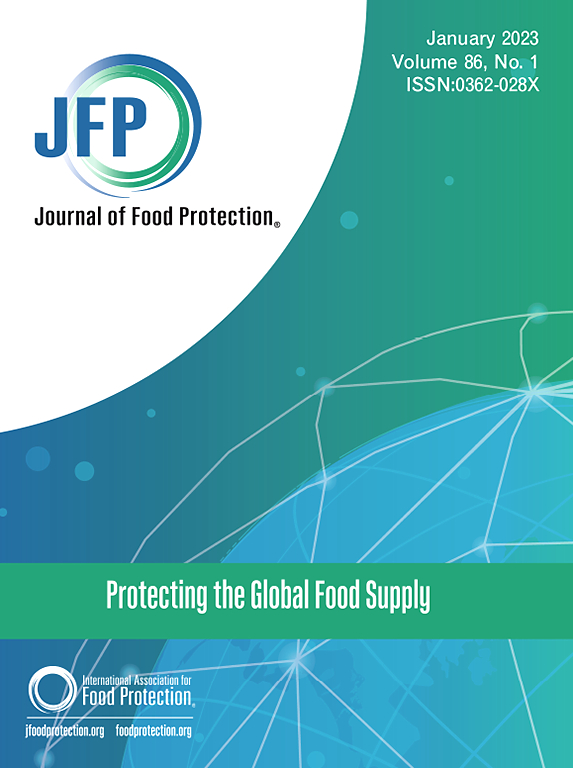The Impact of Training Intervention on Levels of Indicator Bacteria and Prevalence of Selected Pathogens in Raw Milk From Smallholder Women Dairy Farmers in Central Ethiopia
IF 2.1
4区 农林科学
Q3 BIOTECHNOLOGY & APPLIED MICROBIOLOGY
引用次数: 0
Abstract
Contamination of milk is a serious public health risk, particularly in developing countries such as Ethiopia. Training is a tool for improving the quality and safety of milk. However, its effect on the microbial quality and safety of milk has not been well documented. This study assessed the impact of training interventions on the microbial quality and safety of milk, with a specific focus on smallholder dairy farms. The study was conducted from January to June 2022 in four locations in Central Ethiopia. Milk samples were collected from 120 dairy farmers one week before and four to six weeks after the training and analyzed for total coliforms, thermotolerant coliforms, Escherichia coli, Shiga toxin-producing E. coli (STEC), Salmonella enterica, and Campylobacter jejuni. Total and thermotolerant coliforms were determined by the Most Probable Number (MPN) method; categorized as high (≥1,001 MPN/ml), medium (101 103 MPN/ml), low (21–102 MPN/ml), and very low (≤20 MPN/ml); and analyzed using generalized linear mixed models. Prevalence of E. coli, STEC, S. enterica, and C. jejuni in raw milk samples were 67, 12, 3, and 4% pretraining and 45, 4, 3, and 2% posttraining, respectively. The prevalence of E. coli (p = 0.0389) and STEC (p = 0.0005) was significantly lower posttraining compared to pretraining. Most samples had total coliform counts exceeding 103 MPN/ml pretraining (71%); this proportion decreased to 62% posttraining. The estimated cumulative probability of being in the high category was marginally significantly higher (p = 0.0581) pretraining (76%) compared to posttraining (64%). In conclusion, reductions in the detection of some milk quality and safety parameters were observed. However, a considerable proportion of the milk samples were highly contaminated even after the training. Hence, comprehensive and continued risk mitigation strategies are needed to ensure milk safety for consumers.
培训干预对埃塞俄比亚中部小农妇女奶农原料奶中指示菌水平和选定病原体流行率的影响。
牛奶污染是一个严重的公共健康风险,特别是在埃塞俄比亚等发展中国家。培训是提高牛奶质量和安全的一种手段。然而,其对牛奶微生物质量和安全的影响还没有很好的文献记载。本研究评估了培训干预对牛奶微生物质量和安全的影响,并特别关注小农奶牛场。该研究于2022年1月至6月在埃塞俄比亚中部的四个地点进行。在培训前一周和培训后4 - 6周采集120名奶农的牛奶样本,分析总大肠菌群、耐热大肠菌群、大肠杆菌、产志贺毒素大肠杆菌(STEC)、肠沙门氏菌和空肠弯曲杆菌。采用最可能数(MPN)法测定总大肠菌群和耐热大肠菌群;分为高(≥1001 MPN/ml)、中(101 ~ 103 MPN/ml)、低(21 ~ 102 MPN/ml)、极低(≤20 MPN/ml);并采用广义线性混合模型进行分析。训练前原料奶样品中大肠杆菌、产志贺毒素大肠杆菌、肠链球菌和空肠杆菌的检出率分别为67、12、3%和4%,训练后分别为45、4、3%和2%。与训练前相比,训练后大肠杆菌(p = 0.0389)和STEC (p = 0.0005)的患病率显著降低。大多数样品在训练前大肠菌总数超过103 MPN/ml (71%);这一比例在培训后下降到62%。与训练后(64%)相比,训练前(76%)估计的高类别累积概率(p = 0.0581)略高(p = 0.0581)。总之,一些牛奶质量和安全参数的检测减少了。然而,即使在训练之后,相当一部分牛奶样本仍然受到高度污染。因此,需要全面和持续的风险缓解战略来确保消费者的牛奶安全。
本文章由计算机程序翻译,如有差异,请以英文原文为准。
求助全文
约1分钟内获得全文
求助全文
来源期刊

Journal of food protection
工程技术-生物工程与应用微生物
CiteScore
4.20
自引率
5.00%
发文量
296
审稿时长
2.5 months
期刊介绍:
The Journal of Food Protection® (JFP) is an international, monthly scientific journal in the English language published by the International Association for Food Protection (IAFP). JFP publishes research and review articles on all aspects of food protection and safety. Major emphases of JFP are placed on studies dealing with:
Tracking, detecting (including traditional, molecular, and real-time), inactivating, and controlling food-related hazards, including microorganisms (including antibiotic resistance), microbial (mycotoxins, seafood toxins) and non-microbial toxins (heavy metals, pesticides, veterinary drug residues, migrants from food packaging, and processing contaminants), allergens and pests (insects, rodents) in human food, pet food and animal feed throughout the food chain;
Microbiological food quality and traditional/novel methods to assay microbiological food quality;
Prevention of food-related hazards and food spoilage through food preservatives and thermal/non-thermal processes, including process validation;
Food fermentations and food-related probiotics;
Safe food handling practices during pre-harvest, harvest, post-harvest, distribution and consumption, including food safety education for retailers, foodservice, and consumers;
Risk assessments for food-related hazards;
Economic impact of food-related hazards, foodborne illness, food loss, food spoilage, and adulterated foods;
Food fraud, food authentication, food defense, and foodborne disease outbreak investigations.
 求助内容:
求助内容: 应助结果提醒方式:
应助结果提醒方式:


